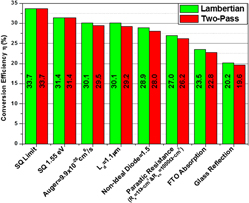Published online by Cambridge University Press: 14 June 2016

The key to improve the conversion efficiency of perovskite solar cells lies in the identification and control of different limiting factors. Both intrinsic and extrinsic losses are shown here to be detrimental on conversion efficiency well below the thermodynamic limit. The effect of varying radiative and Auger recombination processes as inevitable intrinsic losses on device performance is shown in this work. The extrinsic losses are shown to impose severe bounds on efficiency limits. Such extrinsic losses include realistic material optical properties, finite diffusion length, ideality factor, parasitic resistance, and parasite absorption. Thus, this work presents the roadmap and the possible approaches in achieving performance beyond what is currently demonstrated in the highest efficiency perovskite solar cells. Additionally, the impact of light concentration, important in Auger limited devices is investigated. Finally, the impact of Auger recombination for perovskite with finite diffusion length in a two-terminal perovskite/silicon tandem device is investigated.